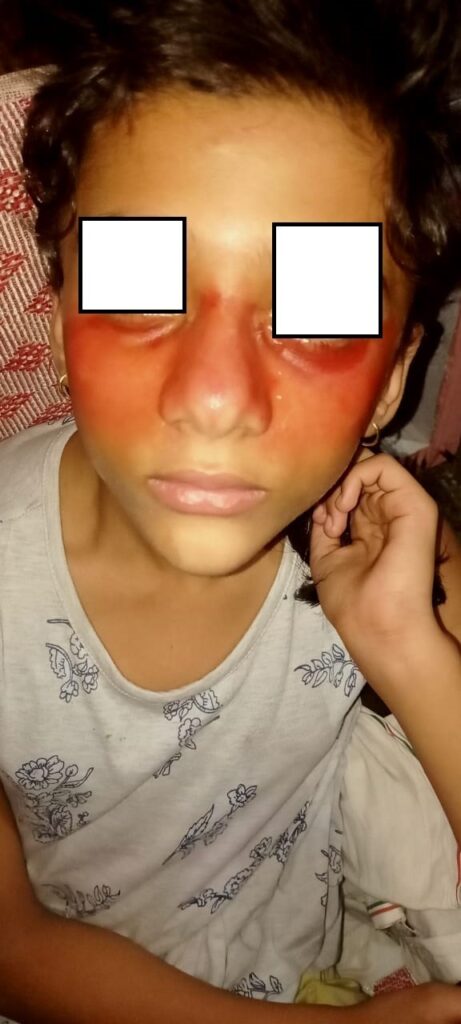Rashmi Singh1*
1Assistant Professor, Department of Dermatology, Heritage Institute of Medical Sciences, India
*Corresponding Author: Rashmi Singh, Assistant Professor, Department of Dermatology, Heritage Institute of Medical Sciences, India; E-mail: [email protected]
Published Date: 24-08-2021
Copyright© 2021 by Singh R, et al. All rights reserved. This is an open access article distributed under the terms of the Creative Commons Attribution License, which permits unrestricted use, distribution, and reproduction in any medium, provided the original author and source are credited.
Abstract
Apocrine chromohidrosis and eccrine pseudochromohidrosis are both rare skin presentations. In case of former patient presents with coloured sweats in apocrine distributions usually axilla, breast etc., while later presents with coloured sweat in eccrine distribution.
Such cases need to be reported after other possibilities with similar presentations have been ruled, and need special mention in literature as mostly they are misdiagnosed as factitious.
Hereby, I am also reporting one such case of pseudochromohidrosis which needed attention as it was causing anxiety to both patient and family members and its proper diagnosis and treatment brought a great relief to them.
Keywords
Chromohidrosis; Pseudochromohidrosis; Rare Apocrine; Eccrine; Coloured Sweat
Introduction
Chromhidrosis and pseudochromhidrosis are rarely reported skin conditions. Chromhidrosis is the production of colored sweat from sweat glands containing lipofuscin pigments and mostly apocrine in origin and pseudochromhidrosis is production of colorless sweat, which becomes colored when it reaches the skin and comes in contact with extrinsic agents such as chromogenic bacterial products, fungi, dyes, paint, and colored foods [1-3]. Rarely, chromohidrosis of eccrine origin may be due to excessive amount of colouring agents or dyes consumed in diet and later secreted in sweat.
Through this case report, the author wants to draw the attention of readers towards an extraordinary case of pseudochromohidrosis, as such cases often lead to social isolation because of fear of humiliation among children.
A nine year old girl, resident of Varanasi, presented to the skin outpatient department of Heritage Institute of Medical Sciences (HIMS), Bhadvar, Varanasi with complaints of sudden onset reddish discoloration of her face starting from under eyelids downwards on the face and neck with progressively advanced area of involvement in each episode. The patient’s skin and mucosa were normal on examination. Patient had no discoloration of axillary sweat. Patient’s condition had been previously diagnosed as irritant contact dermatitis and systemic lupus erythematosus and she had received oral and topical steroid and hydroxychloroquin respectively without any success in treatment. Further, history revealed by her mother emphasized that patient developed red discolouration when she played or sweated for some time.
History of any deliberate application of coloured items on face was negative. Patient’s mother was requested for a video call when such lesions appeared, a video recording of same to be done and to wipe lesions with alcohol swab, in the same video.
Patient’s photograph has also been taken with red discolouration on face (Fig. 1) (For details, check: https://athenaeumpub.com/wp-content/uploads/JDR-02-026.mp4)
Patient’s family members never suffered such illness in past. Investigations including antinuclear antibody, coagulation profile and urine examination was normal. Microbiological examination of red colour material showed no growth.
The condition was finally diagnosed as peudochromohidrosis. Treatment advised was erythromycin tablet 500 mg twice daily for 5 days and topical clindamycin gel twice daily on whole face for 1 month.
Patient did not develop any discoloration in follow up visits till 2 months after the last day of treatment.

Figure 1: Picture showing appearance of red color sweat on face.
Discussion
This patient had pseudochromohidrosis can be concluded from the fact that she developed such discoloration only on face and patient had no history of any dietary intake of any coloured food or any drug or dye or any topical application, and face being a habitat for corneybacterium and other such bacteria which can cause sweat discoloration.
Further, negative ANA report and absence of photosensitivity and systemic symptoms ruled out systemic lupus erythematosus.
In a similar report Koley and Mandal didn’t find any growth of microorganism in culture or microscopic examination [4].
Thami and Kanwar have also reported such case of red pseudochromohidrosis on face in which no growth of microorganism was seen [1].
Ohanna Eva Constance Burggraaff and colleagues in 2019 reported a case of pseudochromohidrosis and they found no growth of organisms in microbiological examination nor did they find lipofuschin granules in histopathology of lesional skin biopsy [5].
A similar case of blue pseudochromohidrosis was reported by Christoffer Aam Ingvaldsen and his colleauges in 2020 but in this case growth of Bacillus cereus was seen in microbiological examination which is a pigment producing bacillus [6].
The absence of growth of any organism in various studies and ours can be explained by the fact that many commensal organisms are also present on face and may interfere with the growth of concerned organisms.
But, we should always advise microbiological examinations in such extraordinary cases to establish correct diagnosis and report them.
Moreover, pseudochrpmohidrosis is a diagnosis of exclusion as it responds to antibiotics oral and topical unlike chromohidrosis in which treating physician focuses on reducing sweat production.
Conclusion
Though, in our case it was quite difficult to differentiate between chromohidrosis and pseudochromohidrosis, but response of later to macrolide antibiotics as erythromycin and azithromycin, indicated that, there are high chances of cornebacterium, being a culprit in such cases.
The purpose of reporting this case is to draw the attention of dermatologists to such cases which mimics factitious diseases and many a times is a cause of emotional trauma due to social stigma of going in public.
References
- Thami GP, Kanwar AJ. Red facial pseudochromhidrosis. Br J Dermatol. 2000;142:1219-20.
- Singal A, Thami GP. Red pseudochromhidrosis of the neck. Clin Exp Dermatol. 2004;29:548-9.
- Castela E, Thomas P, Bronsard V, Lacour JP, Ortonne JP, Passeron T. Blue pseudochromhidrosis secondary to topiramate treatment. Acta Derm Venereol. 2009;89:538-9.
- Koley S, Mandal RK. Red and black pseudochromhidrosis. Indian J Dermatol. 2016;61:454-7.
- Burggraaff JEC, Linthorst GE, Hoogerwerf JJ. Transient blue skin: Pseudochromhidrosis. Euro J Case Reports Int Med. 2014;1(1):1-4.
- Ingvaldsen CA, Leegaard TM, Kravdal G, Mørk C. Infectious pseudochromhidrosis: a case report and literature review. Acta Derm Venereol. 2020;100(1):1-7.
Article Type
Opinion Article
Publication History
Received Date: 14-07-20201
Accepted Date: 16-08-2021
Published Date: 24-08-2021
Copyright© 2021 by Papadopoulos I, et al. All rights reserved. This is an open access article distributed under the terms of the Creative Commons Attribution License, which permits unrestricted use, distribution, and reproduction in any medium, provided the original author and source are credited.
Citation: Singh R. A Case of Pseudochromohidrosis Cured with Oral Erythromycin and Topical
Clindamycin. J Dermatol Res. 2021;2(2):1-4.

Figure 1: Picture showing appearance of red color sweat on face.


